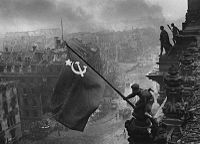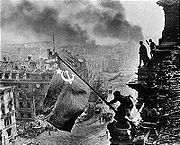
Raising a flag over the Reichstag
Encyclopedia

World War II
World War II, or the Second World War , was a global conflict lasting from 1939 to 1945, involving most of the world's nations—including all of the great powers—eventually forming two opposing military alliances: the Allies and the Axis...
photograph
Photograph
A photograph is an image created by light falling on a light-sensitive surface, usually photographic film or an electronic imager such as a CCD or a CMOS chip. Most photographs are created using a camera, which uses a lens to focus the scene's visible wavelengths of light into a reproduction of...
taken during the Battle of Berlin
Battle of Berlin
The Battle of Berlin, designated the Berlin Strategic Offensive Operation by the Soviet Union, was the final major offensive of the European Theatre of World War II....
on 2 May 1945, by Yevgeny Khaldei
Yevgeny Khaldei
Yevgeny Khaldei was a Red Army photographer, best known for his World War II photograph of a Soviet soldier Raising a flag over the Reichstag, in Berlin, capital of the vanquished Nazi Germany .-Life:...
. It depicts several Soviet troops
Red Army
The Workers' and Peasants' Red Army started out as the Soviet Union's revolutionary communist combat groups during the Russian Civil War of 1918-1922. It grew into the national army of the Soviet Union. By the 1930s the Red Army was among the largest armies in history.The "Red Army" name refers to...
raising the flag of the Soviet Union
Flag of the Soviet Union
The flag of the Soviet Union consisted of a plain red flag, with a setting or cross-peen hammer crossed with a sickle and a red star in the upper canton...
atop the German Reichstag building. The photograph was instantly popular, being reprinted in thousands of publications. It came to be regarded around the world as one of the most significant and recognizable images of the war.
The identities of the men in the picture were often disputed, also that of the photographer (Khaldei), who was only identified after the fall of the Soviet Union. The photograph is full of symbolism and represents a historic moment.
Erected in 1894, the Reichstag's architecture was magnificent for its time. The building contributed much to German history and was considered by the Red Army
Red Army
The Workers' and Peasants' Red Army started out as the Soviet Union's revolutionary communist combat groups during the Russian Civil War of 1918-1922. It grew into the national army of the Soviet Union. By the 1930s the Red Army was among the largest armies in history.The "Red Army" name refers to...
the symbol of their enemy. In reality, the Reichstag had not been used for any official purposes since the 1933 fire
Reichstag fire
The Reichstag fire was an arson attack on the Reichstag building in Berlin on 27 February 1933. The event is seen as pivotal in the establishment of Nazi Germany....
and had never been fully repaired. After very bloody and fierce combat within its walls, the Soviets finally captured the Reichstag on 2 May 1945, drawing closer to the end a war that had cost the lives of many millions of Germans and Soviets.
Celebrated as the image is, it was the reconstruction of a moment that had happened earlier but had been missed by the camera.
Background

The Battle of Berlin
Battle of Berlin
The Battle of Berlin, designated the Berlin Strategic Offensive Operation by the Soviet Union, was the final major offensive of the European Theatre of World War II....
was the final major offensive
Offensive (military)
An offensive is a military operation that seeks through aggressive projection of armed force to occupy territory, gain an objective or achieve some larger strategic, operational or tactical goal...
of the European Theatre
European Theatre of World War II
The European Theatre of World War II was a huge area of heavy fighting across Europe from Germany's invasion of Poland on September 1, 1939 until the end of the war with the German unconditional surrender on May 8, 1945...
of World War II and was designated the Berlin Strategic Offensive Operation by the Soviet Union
Soviet Union
The Soviet Union , officially the Union of Soviet Socialist Republics , was a constitutionally socialist state that existed in Eurasia between 1922 and 1991....
. Starting on 16 January 1945, the Red Army breached the German
Nazi Germany
Nazi Germany , also known as the Third Reich , but officially called German Reich from 1933 to 1943 and Greater German Reich from 26 June 1943 onward, is the name commonly used to refer to the state of Germany from 1933 to 1945, when it was a totalitarian dictatorship ruled by...
front as a result of the Vistula–Oder Offensive and rapidly advanced westward through Germany, as fast as 30–40 kilometres a day. The battle for Berlin
Battle in Berlin
The Battle in Berlin was an end phase of the Battle of Berlin. While the Battle of Berlin encompassed the attack by three Soviet Army Groups to capture not only Berlin but the territory of Germany east of the River Elbe still under German control, the Battle in Berlin details the fighting, and...
lasted from late 20 April 1945 until 2 May and was one of the bloodiest in history. As Berlin fell, Red Army photographer
War photography
War photography captures photographs of armed conflict and life in war-torn areas.Although photographs can provide a more direct representation than paintings or drawings, they are sometimes manipulated, creating an image that is not objectively journalistic.-History:Photography, presented to the...
Yevgeny Khaldei
Yevgeny Khaldei
Yevgeny Khaldei was a Red Army photographer, best known for his World War II photograph of a Soviet soldier Raising a flag over the Reichstag, in Berlin, capital of the vanquished Nazi Germany .-Life:...
gathered some soldiers together in the hope of getting a defining photograph like the American Iwo Jima flag picture
Raising the Flag on Iwo Jima
Raising the Flag on Iwo Jima is a historic photograph taken on February 23, 1945, by Joe Rosenthal. It depicts five United States Marines and a U.S. Navy corpsman raising the flag of the United States atop Mount Suribachi during the Battle of Iwo Jima in World War II.The photograph was extremely...
.
Taking the photo
The events surrounding the flag-raising are murky due to the confusion of the battle to take the number one target in Berlin, the Reichstag. On 30 April there was great pressure to take the building, (seen as symbolic and at the heart of the "fascist beast"), before May day. Initially, two planes dropped several large red banners on the roof that appeared to have caught on the bombed-out dome. Additionally a number of reports had reached headquarters that two parties, M.M. Bondar from the 380th Rifle Regiment and Captain V.N. Makov of the 756th might have been able to hoist a flag during the day of 30 April. These reports were received by Marshal G.K. ZhukovGeorgy Zhukov
Marshal of the Soviet Union Georgy Konstantinovich Zhukov , was a Russian career officer in the Red Army who, in the course of World War II, played a pivotal role in leading the Red Army through much of Eastern Europe to liberate the Soviet Union and other nations from the Axis Powers' occupation...
who issued an announcement stating that his troops had captured the Reichstag and hoisted a flag. However, when correspondents arrived they found no Soviets in the building but were in fact pinned down outside by German fire. After fierce fighting a flag was raised at 10:40 PM on 30 April 1945 when 23-year old Mikhail Minin
Mikhail Minin
Mikhail Petrovich Minin was a Russian Soviet soldier who was the first to enter the Reichstag building on April 30, 1945 during the Battle of Berlin, and the first soldier to mount the flag on the Reichstag building at 10:40 pm.The iconic picture showing a Georgian soldier, Meliton Kantaria,...
climbed the building and inserted a flag into a mounted statue's (Germania's), crown. As this happened at night, it was too dark to take a photograph. The next day the flag was taken down by the Germans. The Red Army finally controlled the entire building on 2 May.
On 2 May 1945 Khaldei scaled the now pacified Reichstag to take his picture. The official story was that two hand-picked soldiers: a Georgian, Meliton Kantaria
Meliton Kantaria
Meliton Varlamovich Kantaria or Kantariya , Hero of the Soviet Union , was a Georgian sergeant of the Soviet Army credited to have together with M. A...
(selected to please Stalin who was also Georgia
Georgia (country)
Georgia is a sovereign state in the Caucasus region of Eurasia. Located at the crossroads of Western Asia and Eastern Europe, it is bounded to the west by the Black Sea, to the north by Russia, to the southwest by Turkey, to the south by Armenia, and to the southeast by Azerbaijan. The capital of...
n) and a Russian, Mikhail Yegorov
M. A. Yegorov
Mikhail Yegorov, along with Meliton Kantaria, was one of the two soldiers credited with raising the Soviet flag over the Reichstag on the 2 May 1945 after the Battle of Berlin.- See also :*Raising the Flag on Iwo Jima...
, had raised the flag. However, it later emerged that for political reasons the subjects of the photograph were changed and the actual man to hoist the flag was Alyosha Kovalyov. Accounts would emerge that Kovalyov, a Ukrainian, was told by the NKVD to keep quiet about his flag raising. To confuse events further, there were reports that a group of men led by Sergei E. Sorokin also planted a flag on the roof.
Aftermath
The photo was published 13 May 1945 in the OgonyokOgonyok
Ogoniok is one of the oldest weekly illustrated magazines in Russia, issued since . It was re-established in the Soviet Union in 1923 by Mikhail Koltsov....
magazine. While many photographers took pictures of flags on the roof, it was Khaldei's image that stuck.
Image censored
After taking the symbolic photo, Khaldei quickly returned to MoscowMoscow
Moscow is the capital, the most populous city, and the most populous federal subject of Russia. The city is a major political, economic, cultural, scientific, religious, financial, educational, and transportation centre of Russia and the continent...
. He further edited the image at the request of the editor-in-chief of the Ogonyok
Ogonyok
Ogoniok is one of the oldest weekly illustrated magazines in Russia, issued since . It was re-established in the Soviet Union in 1923 by Mikhail Koltsov....
, who noticed that Sen. Sgt. Abdulkhakim Ismailov
Abdulkhakim Ismailov
Abdulkhakim Ismailov was a Soviet soldier within the Soviet Union's Red Army during World War II. He was photographed by Yevgeny Khaldei raising the flag of the Soviet Union over the Reichstag in Berlin in May 1945, three days before Nazi Germany's surrender.Abdulkhakim Ismailov, a native of...
, who is supporting the flag-bearer in the photo, was wearing a watch on one of his wrists. On the other was an Adrianov compass
Adrianov compass
The Adrianov compass is a military compass designed by Russian Imperial Army topographist Vladimir Adrianov in 1907. Wrist-worn versions of the compass were then adopted and widely used by the Red and Soviet Army....
, which resembled another watch and one could infer that Ismailov had looted
Looting
Looting —also referred to as sacking, plundering, despoiling, despoliation, and pillaging—is the indiscriminate taking of goods by force as part of a military or political victory, or during a catastrophe, such as during war, natural disaster, or rioting...
the pieces or otherwise acquired them illegally. Although the practice of wearing both a compass and a watch was widespread in the Red Army, Khaldei, in order to avoid controversy, doctored the photo to remove the watch from Ismailov's right wrist. Khaldei also copied smoke in the background of another photo to make the scene more dramatic.

